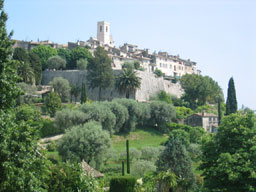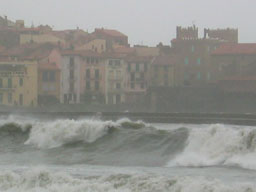
|
|
|
Home Chasing Matisse: The Book Chasing Matisse Preview: Cover and Prologue Buy The Book Book Signing Schedule News & Reviews James Morgan's Bio Beth Arnold's Bio Book's Press Release Leaving Home Introduction to the Journey Travel Itinerary Beth's Travel Diary The Sketchpad Photo Gallery Travel Notes and Recommendations for France, Corsica and Morocco Chasing Matisse Newsletter Contact Us
|

 View All Diary Entries Here View All Diary Entries HereFebruary 25, 2004Riders of the Storm The wind howled, and rain steadily pounded the roofs and streets, land and sea throughout the night. The leak in our skylight that streamed down Matisse's "Odalisque á la culotte grise" for the first time when we were away, was back and silent drops of water were glazing the floor. I stayed up and read. I was close to finishing Marie Antoinette by Antonia Fraser, and since I've become quite fascinated with "that Austrian woman" as the French would say as a slur during the lifetime of this much and wrongly maligned Queen of France (in Ms. Frazier's opinion and now mine as well), I couldn't put the heavy tome down. I am on a course of reading French history to understand the roots of the country I'm in. I've gone from Middle Ages to Revolution, or to put it another way, from murder, mayhem and pillaging to murder, mayhem and pillaging. Some things don't seem to change in time with the exception of who is doing it to whom. Constant warfare together with inhumane atrocities weren't a daily routine in the France of the 18th Century as in the 11th and 12th, when survival often depended upon the whims of one's ruler and/or conqueror as well as the Pope and Church, and what terror was improvised and who owed what revenge to whom. That is, until the people rose up against the royal family and aristocracy and chopped off so many heads that streets ran thick with blood. As the heads, hearts, and various other entrails of whoever was the last to be tried and found guilty of some treason real or made up were paraded upon pikes around town, the rioters were literally covered in the sticky red fluid that courses through life or drains from the lack of it. The radicals were evidently delighted to mutilate bodies, which is a bit disappointing, but the blood of their victims reflected some sort of (twisted and anti) communion with their freedom. The point of changing the system in France was valid; these actions dubious at best. But this is inevitably the question of revolution: must it be murderous and violent? One day this storm would pass though martyred Queen Marie Antoinette, who desperately tried to protect her children and husband, in the end could not. Her nightmare of a tempest didn't stop until death found her on the guillotine, and she met it with grace and dignity. I love a good storm and the uneven lament of the wind. My sun and moon chimes on the balcony were jangling so hard I worried they would be ripped apart and tossed to Ceret, but I left them alone. Even after I crawled under the covers at 2 am, I listened as the driving rain hit the tiles on the roof and the wind yowled through the black night. _________________ On the Côte d'Azur, we motored the short distance from Vence to St-Paul-De-Vence, the charming hilltop village that is home of the renowned restaurant La Colombe d'Or.  The beauty and authenticity of the haute village that drew painters like Matisse, Derain, Picasso, Dufy, and Braque who traded their art for meals at this local eatery still remains but is difficult to discover with the crowds that surge through. La Colombe d'Or with its paintings had to be on our list of to-do's. Our friend Jeffrey had once known the owner fairly well, and another acquaintance said that he did, though that was one of his recurrent, pathological (and at least in this case, harmless) perjuries. The beauty and authenticity of the haute village that drew painters like Matisse, Derain, Picasso, Dufy, and Braque who traded their art for meals at this local eatery still remains but is difficult to discover with the crowds that surge through. La Colombe d'Or with its paintings had to be on our list of to-do's. Our friend Jeffrey had once known the owner fairly well, and another acquaintance said that he did, though that was one of his recurrent, pathological (and at least in this case, harmless) perjuries. We walked into the garden doors of La Colombe d'Or to inquire about lunch sans reservation. In this case, I think it was quite unusual we got a table though we did. The jardin and view were glorious. Some American senator was lunching next to us and a Hollywood-looking group held court for each other to our right. An African-American actor/athlete/musician/businessma--we couldn't quite tell what, though he was wearing a beautiful woman as his most elegant accessory and talking on the phone a lot--was dressed in a baggy basketball uniform as his stylish ensemble instead of the linen jacket the senator sported. He was joined by someone who spent a lot of energy sucking up to him. We might as well have been in the States for the company. When we didn't order a three-course meal, which was larger and more expensive than we wanted, there was a discussion between our waiter and possibly the manager. It seemed to be about whether they would let us stay with such a picayunish request for our repast. But they did, and we enjoyed a wonderful lunch of two entrees (first courses). The first was an assiette of crudites which I have ordered several times before but not like this. They must have brought 20 little bowls and plates of everything from anchovies to eggplant to lentils to pates. It was a feast in itself for three or four adults, but we'd also ordered shrimp that were huge and good as well. Afterwards, we wandered through the dining room, where we gazed upon some of the celebrated art including a Matisse. Were they the originals? I don't know, but how could such treasures be left on the walls with hordes of people coming and going. I doubt it though the sight thrilled us anyway. Overall, we were not dying to reserve a table for another meal or be overnight guests. La Colombe d'Or was as haughty as St-Paul-de-Vence was haute-y. Not a place we wanted to stay. Along with the ample numbers of tourists, whatever simple goodwill and love of art that originally inspired the collecting of these now-legendary artists has been replaced by arrogant commercialism. We were off to another St-Paul institution, the Fondation Maeght. I was not bowled over by the Maeght collection, or at least what I saw of it or the show at that time. The Maeghts were obviously knowledgeable, sophisticated, and connected to some of the greatest artistic talent of the 20th Century. They had an "eye." Does it make me a blockhead not to have taken as much pleasure in these works, or at least the portion I saw of them, than in others I've viewed? Possibly it was just the day or my taste is merely not the same. I think I have to go back and try again. I can imagine the excitement of knowing these artists and watching them create their visions, interpretations of their worlds, modern revelation--seeing the paint on canvas for the first time, having the ability to support their work, and being part of this heady place and time. Not bad, as M. Malric of the Hotel St. Germain would say. That night our new friend and directress of Matisse's Villa La Reve, Joelle, invited us for a drink, and we sat on her terrace with a cool Pastis as her daughter Sourya played near the table. Joelle told us we could stay an extra day if we liked. Liked? We were turning cartwheels. We'd already stayed one extra day, and the truth was, we could've happily stayed another week or four. In the Arkansas fury I was facing since my mother's death, I felt safe in the big chopped-up house and wild garden, and Jim was lost in the spirit of Matisse. _______________  Last Saturday in Collioure, the day after the storm, it rained on and off and the sea was in turmoil. Waves crashed and sprayed against the ramparts of the Chateau Royale and covered the path around it. There was no beach. Debris had washed up and down streets. Fervent surfers dressed in wet-suits caught and rode gigantic waves into a rock wall for shore. Last Saturday in Collioure, the day after the storm, it rained on and off and the sea was in turmoil. Waves crashed and sprayed against the ramparts of the Chateau Royale and covered the path around it. There was no beach. Debris had washed up and down streets. Fervent surfers dressed in wet-suits caught and rode gigantic waves into a rock wall for shore.In my dictionary of symbolism, the storm is said to represent "a powerful manifestation of the gods and their will." For me, it is true that part of a storm's attraction is its natural majesty, and in my novel Innocent Lanier, the whole book is turned on a potent tornado that spins the characters' worlds around. I dream of these whirling winds as well. If storms carry messages of the gods' will, then the world must have thundered when France revolted and massacred the establishment that needed reborn. And in a quieter fashion, a tempest blew again to split open the bindings of art when Matisse and Picasso covered canvas with their rich imaginings. They were riders of the storm that they themselves created, and they were lucky enough to catch the cultural wave and tame it. But no matter where the lightning strikes, as the winds of change howl, so does man. We all must ride the storms that are thrown us. Or get bucked off and drown. posted by Beth on February 25, 2004 | View All Diary Entries  View All Diary Entries Here View All Diary Entries Here |
Copyright © 2005 James Morgan & Beth Arnold. All rights reserved
|
|
